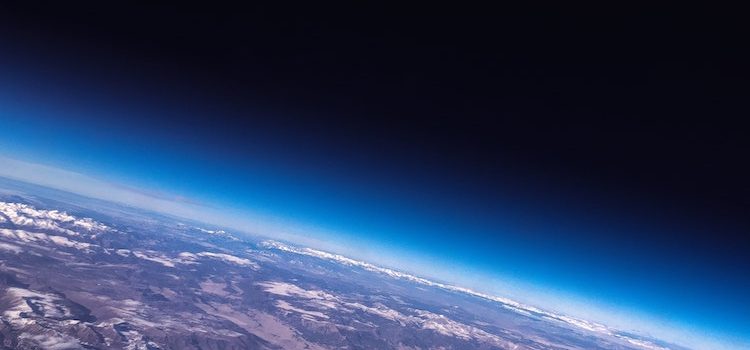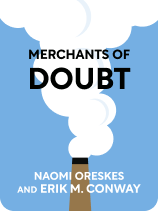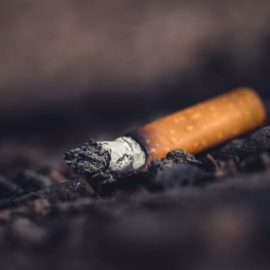

This article is an excerpt from the Shortform book guide to "Merchants of Doubt" by Naomi Oreskes and Erik M. Conway. Shortform has the world's best summaries and analyses of books you should be reading.
Like this article? Sign up for a free trial here .
What are the causes and effects of ozone depletion? What’s the science? What doubts have been raised?
Since the 1970s, the public controversy about the causes and effects of ozone depletion has been fueled by those who believe that certain environmental policies put their agenda at risk. These “merchants of doubt” seek to undermine the credibility of the science behind such policies. Naomi Oreskes and Erik Conway discuss this in their book Merchants of Doubt.
Read more to learn about the history of the debate surrounding the causes and effects of ozone depletion.
The Early Debate About the Causes and Effects of Ozone Depletion
The discovery of the ozone hole was roundabout—scientists found it while studying something else.
Supersonic Transports (SSTs)
In the late 1960s, the U.S. wanted to build supersonic transports (SSTs), commercial planes that could break the sound barrier. Unlike regular planes, the SST would travel in the stratosphere, and scientists were concerned the plane’s exhaust (composed of carbon dioxide, water vapor, and nitrogen oxides (NOX)) might damage the environment because:
- Carbon dioxide and water vapor are greenhouse gases.
- Water vapor contributes to cloud formation, which can change the weather.
- Water vapor and NOX might deplete the stratospheric ozone layer. By the 1970s, scientists knew that the ozone layer blocked the sun’s UV radiation, which could cause some types of skin cancer.
In 1970, two notable studies tackled the issue:
1. MIT released a study (SCEP) about human environmental impact that, among other things, considered the effect of the SSTs on the stratosphere. Scientists found that an SST fleet would increase the concentration of water vapor in the stratosphere but probably wouldn’t change the planet’s temperature. The study also noted that NOX probably wouldn’t affect atmospheric ozone.
2. A Boeing Laboratories scientist found that 850 SSTs wouldn’t have a large effect on surface temperatures. He did find, however, that the emissions would cause a 2-4% reduction in the ozone column.
Nitrogen Oxides (NOX)
In March 1971, the Department of Transportation held a conference on stratospheric flight. One of the attendees, Harold Johnston, an atmospheric chemist, disagreed with the SCEP study’s conclusion that NOX wouldn’t significantly deplete ozone. Johnston handwrote a paper while at the conference that showed that NOX would have a huge effect—10-90% ozone depletion, depending on region. The higher-air-traffic regions, such as the North Atlantic, would see the greatest depletion.
The causes and effects of ozone depletion were still largely unknown. None of the other scientists were very worried about NOX, but Johnston was so vehement they recommended doing more research on NOX at the end of the conference. No one knew how much NOX was currently in the atmosphere, so it was impossible to know if the SST emissions would be a drop in the bucket or a huge amount.
Johnston revised his handwritten paper and tried to publish it in Science. The peer reviewers rejected it because Johnston hadn’t cited an important paper on NOX and because his tone was biased—he wrote that an SST fleet would deplete ozone concentration by 50% and cause blindness. Johnston went to work revising it, but an earlier draft leaked to the press. The PR department at the University of California released the leaked draft officially, which brought the issue of the causes and effects of ozone depletion into public consciousness.
Policy and Public Action
The House of Representatives ultimately voted to cancel the supersonic transport (SST) program because it was too expensive (not because of environmental concerns). However, other countries were looking at stratospheric flight too, and the Department of Transportation wanted to look at other types of SSTs, so in 1972, Congress funded a Climate Impact Assessment Program (CIAP). It was one of the first studies to preemptively assess a technology, and it would take three years.
Further Exploration of the Science
Interest grew in the causes and effects of ozone depletion. At the same time CIAP was going on, scientists started thinking beyond NOX and wondered what effect other emissions, notably chlorine, might have on ozone. Two notable studies addressed the issue:
1. NASA’s 1973 Environmental Impact Statement for their shuttle program. Two scientists at the University of Michigan studied the exhaust of rocket boosters that used a chlorine-based fuel and found that chlorine destroys ozone. One NASA office tried to bury the results and the two scientists were asked to keep the shuttle out of their findings. They wrote a paper about causes and effects of ozone depletion, sharing the ozone-destroying effects of chlorine but mentioning only volcanoes as a source of chlorine.
2. Rowland and Molina, 1974. These two scientists predicted that chlorofluorocarbons (CFCs)—industrial chemicals used in aerosols and fridges—would eventually make their way into the stratosphere and, due to UV radiation, break down into compounds that would destroy ozone. The reactions were complicated, but the proof was simple—if chlorine monoxide was present in the atmosphere, it had definitely come from chlorine breaking down ozone, because there was no other way it could have gotten there. However, it was hard to measure chlorine monoxide because it’s so reactive that when it touches an instrument, it vanishes.
The conversation about causes and effects of ozone depletion became more public as the press covered Rowland and Molina’s work.
The MOD’s Response
The CFC industry responded by doing their own research. The Manufacturing Chemists’ Association gave out millions of dollars in research grants, mainly to universities, and established two PR organizations.
MODs also tampered with the Climate Impact Assessment Program (CIAP) results. In January 1975, CIAP’s scientists (almost 1,000) concluded that 500 SSTs would likely hugely deplete the ozone layer above the North Atlantic and generally deplete the layer by 10-20%.
The Executive Summary, however, didn’t give any of this information about causes and effects of ozone depletion. It was written by the Department of Transportation, and it discussed a yet-to-be-developed version of the SST that wouldn’t harm the ozone layer.
After the summary was released in a press conference, the press attacked the scientists for being alarmists and unscientific. The public concluded that SSTs wouldn’t hurt the ozone layer.
Setting the Record Straight
Some of the scientists tried to publish the real findings behind the misleading executive summary. Newspapers wouldn’t print them. One scientist finally got Science to publish a letter, which forced the Department of Transportation to acknowledge their meddling, but the exchange took place entirely in Science, which the general public doesn’t read.
Further Exploration of the Science
In January 1975, the Ford administration put together a panel to consider the Inadvertent Modification of the Stratosphere (IMOS). A few months later, the panel recommended that unless new evidence cleared CFCs, they should no longer be used in any way that could release them to the atmosphere.
The IMOS panel asked the National Academy of Sciences (NAS) to look into CFC regulations. Normally, this job would go to a regulatory government agency, such as the Environmental Protection Agency (EPA), and the NAS’s leadership wasn’t happy with the assignment, but they did it. The president of the NAS put together two panels. Anyone who already had a position on CFCs wasn’t allowed to contribute to the reports.
The MOD’s Response
The CFC industry signed up Richard Scorer, a professor of theoretical mechanics. He went on a tour of the U.S. to denounce the Climate Impact Assessment Program (CIAP) study and in-progress work. Scorer said that human activities were so small as to have a negligible effect on the atmosphere, and he called ozone destruction fear-mongering. His tour wasn’t a success—a reporter discovered that he was connected to the CFC industry and he lost his credibility.
Next, the CFC industry tried to blame atmospheric chlorine on volcanoes (magma contains dissolved chlorine). If volcanoes, not CFCs, were responsible for the presence of chlorine in the atmosphere, the atmosphere would naturally contain a lot of chlorine due to volcanic eruptions and the effect of CFCs would be negligible.
There had already been some research on volcanic chlorine, but there was uncertainty around the numbers. When volcanoes erupt, they fire far more than just chlorine into the atmosphere. Water vapor erupts too, and chlorine easily dissolves in water. As a result, a lot of the volcanic chlorine falls back to the earth as rain rather than remaining in the atmosphere.
However, no one had measured how much chlorine rains out, so the CFC’s Council on Atmospheric Sciences tried to prove that most of the chlorine wouldn’t rain out and would instead make its way into the stratosphere. They studied a volcano in Alaska, but results were deemed “inconclusive” and never released, so presumably, they weren’t favorable.
The CFC industry also tried to claim that there was no proof that chlorine destroyed ozone, or that CFCs broke down to make chlorine, or that CFCs even made it into the stratosphere.
Further Exploration of the Science
Scientists made several important discoveries from 1975 to 1976 that impacted the debate about the causes and effects of ozone depletion.
1. Chlorine monoxide was present in the stratosphere. James Anderson built an instrument that could measure it, and he found it. This proved that the reactions Rowland and Molina predicted (CFCs reacted with ozone, breaking it down to produce, among other things, chlorine monoxide) really were happening.
2. One of the model numbers was outdated. Sherry Rowland continued working on ozone and realized that the National Academy of Sciences (NAS) panels had been using a measurement in their models that was probably outdated. Chlorine nitrate breaks down into chlorine and nitrogen in sunlight, and the rate of breakdown hadn’t been measured since the 1950s when scientists found it broke down in the order of minutes. Rowland remeasured and discovered that it broke down more slowly, which means that less chlorine was in the atmosphere than the NAS’s model had predicted. Even though Rowland supported a CFC ban, he released the information immediately.
3. If we kept releasing CFCs in the same quantities as 1973, the ozone layer would steadily deplete. The NAS found that the depletion was approximately proportional to the CFCs released—if emissions halved, depletion would halve. Since it was beyond the scope of the NAS’s role to propose policy, they concluded that there was uncertainty in the predictions but that CFCs should be regulated within the next two years. Many organizations called for immediate regulation.
The MOD’s Response
The CFC industry wasn’t expecting such a timeline. They tried to claim that the study said nothing should be regulated for at least the next two years when what the NAS actually said was that regulations should be in place within the next two years.
Policy and Public Action
Regulations were announced in 1977, but interestingly, the public had already turned away from CFCs and chosen to use alternatives, such as roll-on instead of spray-on antiperspirants. CFC use had dropped 75%.
The CFC ban went into effect in 1979.

———End of Preview———
Like what you just read? Read the rest of the world's best book summary and analysis of Naomi Oreskes and Erik M. Conway's "Merchants of Doubt" at Shortform .
Here's what you'll find in our full Merchants of Doubt summary :
- How doubt-mongering techniques are used to discredit those who threaten a person or company's agenda
- The 10 most common doubt-mongering techniques
- Steps you can take to protect yourself from doubt-mongering






